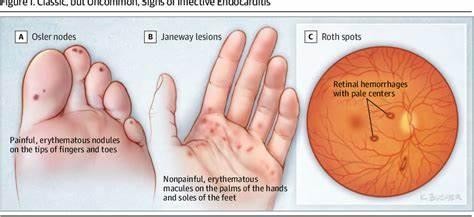An adolescent boy is admitted with the following symptoms: Slow onset of recurrent low-grade fever, fatigue, weakness, joint and muscle aches, loss of appetite, weight loss and diaphoresis.
On assessment the nurse auscultates a new heart murmur, splenomegaly, petechiae, splinter hemorrhages under the nails and Osler nodes (red, painful non-hemorrhagic nodules on the pads of fingers and toes.
Which of the following Acquired Heart Diseases does this best represent?
Infective endocarditis
Tetralogy of Fallot
Acute rheumatic fever
Pulmonary hypertension
The Correct Answer is A
A. The symptoms described, including slow onset of recurrent low-grade fever, fatigue, weakness, joint and muscle aches, loss of appetite, weight loss, and diaphoresis, along with the presence of a new heart murmur, splenomegaly, petechiae, splinter hemorrhages under the nails, and Osler nodes, are classic signs and symptoms of infective endocarditis (IE).

B. Tetralogy of Fallot is a congenital heart defect characterized by four specific abnormalities in the heart's structure. The symptoms described do not align with the characteristic features of Tetralogy of Fallot.
C. Acute rheumatic fever is an inflammatory condition that can develop as a complication of untreated streptococcal infections, particularly strep throat. While it can lead to heart valve damage (rheumatic heart disease), the symptoms described are more indicative of infective endocarditis rather than acute rheumatic fever.
D. Pulmonary hypertension is a condition characterized by elevated blood pressure in the pulmonary arteries. While it can present with symptoms such as fatigue and weakness, it typically does not manifest with the constellation of symptoms described, including fever, joint and muscle aches, and the presence of Osler nodes and splinter hemorrhages.
Nursing Test Bank
Naxlex Comprehensive Predictor Exams
Related Questions
Correct Answer is C
Explanation
A. The frequency of peak flow monitoring should be determined by the healthcare provider and vary depending on the severity of the asthma.
B. Encouraging physical activity is important for overall health, including for children with asthma. Specific sports depend on triggers
C. Identifying and avoiding triggers that can exacerbate asthma symptoms is an essential part of asthma management. By avoiding triggers whenever possible, the child can help prevent asthma attacks and maintain better control of their condition.
D. Cromolyn sodium is a mast cell stabilizer that can help prevent asthma symptoms when used regularly, but it is not typically used for immediate relief of symptoms at the first sign of breathing difficulty. Short-acting bronchodilators, such as albuterol, are usually recommended for quick relief of asthma symptoms.
Correct Answer is B
Explanation
A. Application of antibiotic ointment to the pin sites is not necessary as pins drilled into the bone are not used in buck extension traction.
B. Traction can be removed briefly during baths in cases where a pre-made boot is being used
C. Adequate hydration is essential for overall health and well-being, and fluid restriction could lead to dehydration, especially in a child with increased metabolic demands due to illness or injury.
D. Repositioning every 2 hours may not be necessary, as the child's position is generally stable with the traction device in place.
Whether you are a student looking to ace your exams or a practicing nurse seeking to enhance your expertise , our nursing education contents will empower you with the confidence and competence to make a difference in the lives of patients and become a respected leader in the healthcare field.
Visit Naxlex, invest in your future and unlock endless possibilities with our unparalleled nursing education contents today
Report Wrong Answer on the Current Question
Do you disagree with the answer? If yes, what is your expected answer? Explain.
Kindly be descriptive with the issue you are facing.
